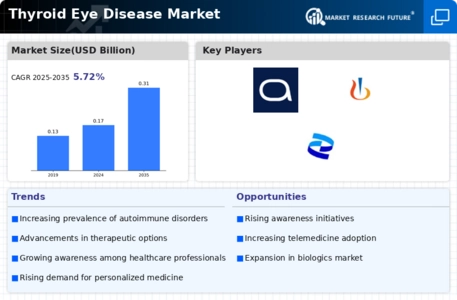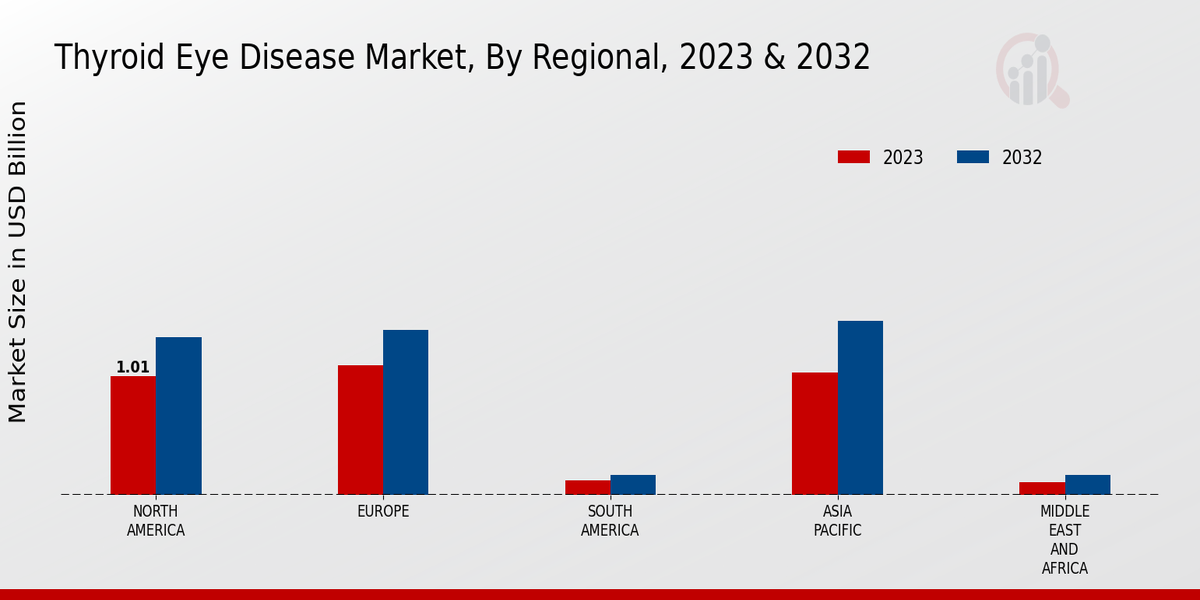Growing Geriatric Population
The aging population is a crucial driver for the Global Thyroid Eye Disease Market Industry. As individuals age, the risk of developing thyroid-related disorders, including thyroid eye disease, increases. This demographic shift is expected to lead to a higher prevalence of the condition, thereby driving demand for effective treatment solutions. With the global geriatric population projected to grow significantly in the coming years, healthcare systems may need to adapt to meet the rising needs of this demographic. Consequently, pharmaceutical companies may focus on developing age-specific therapies, further contributing to market growth.
Market Trends and Projections
The Global Thyroid Eye Disease Market Industry is characterized by various trends and projections that illustrate its growth potential. The market is expected to reach 0.17 USD Billion in 2024, with a projected increase to 0.31 USD Billion by 2035. The compound annual growth rate of 5.51% from 2025 to 2035 indicates a robust expansion trajectory. These figures suggest a growing recognition of thyroid eye disease as a significant health concern, prompting increased investment in research, treatment options, and patient education. The evolving landscape may lead to enhanced therapeutic strategies and improved patient outcomes.
Rising Awareness and Diagnosis
Heightened awareness regarding thyroid eye disease is contributing to the growth of the Global Thyroid Eye Disease Market Industry. Increased educational initiatives and campaigns aimed at both healthcare professionals and the general public are leading to earlier diagnosis and treatment. As awareness rises, more patients are likely to seek medical attention, which could result in a higher demand for therapeutic interventions. This trend may be reflected in the projected compound annual growth rate of 5.51% for the period between 2025 and 2035, indicating a sustained interest in addressing this condition through enhanced diagnostic and treatment options.
Advancements in Treatment Modalities
Innovations in treatment modalities are significantly influencing the Global Thyroid Eye Disease Market Industry. The introduction of novel therapies, including monoclonal antibodies and minimally invasive surgical techniques, is enhancing patient outcomes. As these advancements become more widely adopted, they are expected to drive market growth. The anticipated increase in market value to 0.31 USD Billion by 2035 indicates a robust interest in research and development within this sector. Furthermore, the potential for improved quality of life for patients may encourage healthcare systems to invest in these new treatment options, thereby stimulating market expansion.
Regulatory Support for Innovative Therapies
Regulatory bodies are increasingly supporting the development of innovative therapies for thyroid eye disease, which is positively impacting the Global Thyroid Eye Disease Market Industry. Initiatives aimed at expediting the approval process for new treatments are likely to encourage pharmaceutical companies to invest in research and development. This regulatory environment may lead to a faster introduction of novel therapies, thereby enhancing treatment options available to patients. As the market evolves, the collaboration between regulatory agencies and industry stakeholders could foster a more dynamic landscape, ultimately benefiting patients and healthcare providers alike.
Increasing Prevalence of Thyroid Eye Disease
The Global Thyroid Eye Disease Market Industry is witnessing a rise in the prevalence of thyroid eye disease, driven by the increasing incidence of autoimmune disorders. As more individuals are diagnosed with conditions such as Graves' disease, the demand for effective treatment options is likely to grow. In 2024, the market is projected to reach 0.17 USD Billion, reflecting the urgent need for innovative therapies. This trend suggests that healthcare providers and pharmaceutical companies may focus on developing targeted treatments to address the specific needs of patients suffering from this condition, thereby expanding the market further.














